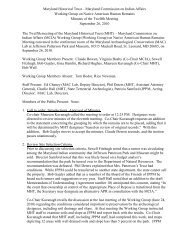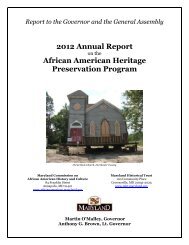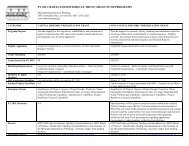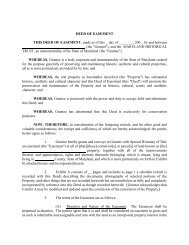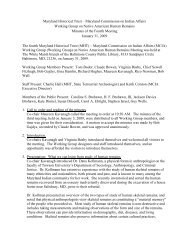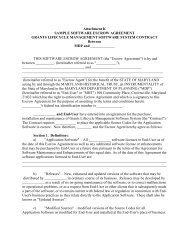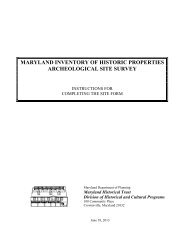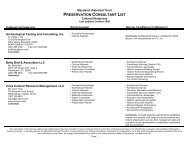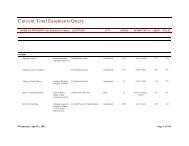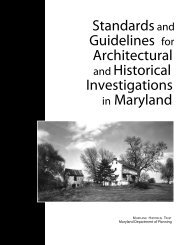The Maryland Preservation Plan - 2005 - Maryland Historical Trust
The Maryland Preservation Plan - 2005 - Maryland Historical Trust
The Maryland Preservation Plan - 2005 - Maryland Historical Trust
- No tags were found...
Create successful ePaper yourself
Turn your PDF publications into a flip-book with our unique Google optimized e-Paper software.
<strong>The</strong> Status of Heritage Resources<strong>The</strong> development of Programmatic Agreements and Memoranda ofAgreement between MHT and federal, State, and local government agenciescan often streamline the project review process. <strong>The</strong>se agreements define areasof concern and outline corresponding action steps at the front end of a project.By identifying statutory requirements and recommended treatments at theoutset, clients are more informed and able to proceed at their own pace.3. Special State ProgramsHeritage <strong>Preservation</strong> and Tourism Areas Program<strong>The</strong> Heritage <strong>Preservation</strong> and Tourism Areas Program, created in1996, assists local communities to promote, protect, and interpret their heritageresources by capitalizing on <strong>Maryland</strong>'s potential for heritage tourism. <strong>The</strong>intent of the program is to promote historic preservation and areas of naturalbeauty to stimulate the creation of new businesses and generate sales, income,and property tax revenues for the State and local jurisdictions. <strong>The</strong> <strong>Maryland</strong>Heritage Areas Authority (MHAA), established as an independent governmentunit operating in the Department of <strong>Plan</strong>ning (as of October 1, <strong>2005</strong>), overseesthe program.<strong>The</strong> program is designed to:• Enhance the visitor appeal and enjoyment of the State’s history, culture,natural environment and scenic beauty by enhancing the visitor experience;• Increase the economic activity associated with tourism, creating opportunitiesfor small business development, job growth, and a stronger tax base;• Encourage preservation and adaptive use of historic buildings, conservationof natural areas important to the State’s character and environment, and thecontinuity of cultural arts, attractions, and traditions indigenous to the region;• Enable <strong>Maryland</strong>ers and visitors alike to have greater access to the historyand traditional cultures of the State and to understand the important eventsthat took place here;• Foster among and between heritage attractions linkages that encouragevisitors to explore, linger, and sample the diverse offerings of the State’sdistinctive regions;• Balance the impact of tourism activity with the quality of life enjoyed byresidents; and• Accomplish these goals via partnerships among local and regional leaders,nonprofit organizations, businesses, and State agencies.National Register Criteria<strong>The</strong> quality of significance in Americanhistory, architecture, archeology,engineering, and culture is present indistricts, sites, buildings, structures, andobjects that possess integrity of location,design, setting, materials, workmanship,feeling, and association, and:A. That are associated with events thathave made a significant contribution tothe broad patterns of our history; orB. That are associated with the lives ofpersons significant in our past; orC. That embody the distinctive characteristicsof a type, period, or method ofconstruction or that represents the workof a master, or that possess high artisticvalues, or that represent a significant anddistinguishable entity whosecomponents may lack individualdistinction; orD. That have yielded, or may be likely toyield, information important in prehistoryor history.<strong>The</strong> process of becoming a heritage area involves two stages. First,communities prepare an application to the <strong>Maryland</strong> Heritage Areas Authorityto become a Recognized Heritage Area (RHA). Once MHAA grants RHAstatus to a heritage area, the RHA is eligible for a matching grant to prepare amanagement plan setting forth the strategies, projects, programs, actions andpartnerships that will be involved in achieving its goals. As of June, <strong>2005</strong>, thereare three Recognized Heritage Areas. With an approved management plan,RHAs become Certified Heritage Areas. Certified Heritage Areas are eligiblefor additional financial benefits. <strong>The</strong>re are ten Certified Heritage Areas, as ofSotterley, in St. Mary's County, is one of<strong>Maryland</strong>'s most important NationalRegister properties.19



